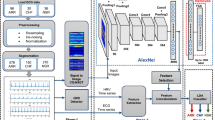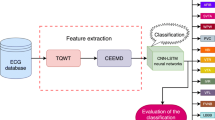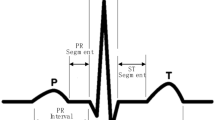Abstract
The electrocardiogram (ECG) is a picture of heart electrical conduction, which is widely used to diagnose many types of diseases such as abnormal heartbeat rhythm (arrhythmia). However, it is very difficult to detect the abnormal ECG characteristics because of the nonlinearity and the complexity of ECG signals from one side, and the noise effect of these signals from the other side, which make it very difficult to perform direct information extraction. Therefore, in this study we propose a very deep convolutional neural network (VDCNN) by using small filters throughout the whole net to reduce the noise affect and improve the performance. Our approach introduces multi-canonical correlation analysis (MCCA), a method to learn selective adaptive layer’s features such that the resulting representations are highly linearly correlated and speed up the training task. Moreover, the Q-Gaussian multi-class support vector machine (QG-MSVM) is introduced for classification, an algorithm which has a better learning performance and generalization ability on ECG signals processing. As a result, we come up with expressively more accurate architecture which is able to differentiate between the normal (NSR) heartbeats and three common types of arrhythmia atrial fibrillation (A-Fib), atrial flutter (AFL), and paroxysmal supraventricular tachycardia (PSVT) without performing any noise filtering or pre-processing techniques. Experimental results show that the proposed algorithm outperforms the state-of-the-art methods.








Similar content being viewed by others
Explore related subjects
Discover the latest articles and news from researchers in related subjects, suggested using machine learning.References
Arrhythmia Irregular Heartbeat Center (2017) Heart disease and abnormal heart rhythm (arrhythmia). https://www.medicinenet.com/arrhythmia_irregular_heartbeat/article.htm. Accessed 12 Nov 2017
National Heart, Lung and Blood Institute (2017) How is heart failure diagnosed? https://www.nhlbi.nih.gov/health/health-topics/topics/hf/diagnosis. Accessed 12 Nov 2017
Atrial Fibrillation ECG Review (2017) https://www.healio.com/cardiology/learn-the-heart/ecg-review/ecg-topic-reviews-and-criteria/atrial-fibrillation-review. Accessed 12 Nov 2017
Healthline (2017) Atrial flutter. https://www.healthline.com/health/heart-disease/atrial-flutter#overview1. Accessed 12 Nov 2017
Medications for Paroxysmal Supraventricular Tachycardia (2017) https://www.drugs.com/condition/paroxysmal-supraventricular-tachycardia.html. Accessed 12 Nov 2017
Sahoo S et al (2016) De-noising of ECG signal and QRS detection using Hilbert transform and adaptive thresholding. Procedia Technol 25:68–75
De Albuquerque VHC et al (2016) Robust automated cardiac arrhythmia detection in ECG beat signals. Neural Comput Appl 1:1–15
Acharya UR et al (2016) Application of empirical mode decomposition (EMD) for automated identification of congestive heart failure using heart rate signals. Neural Comput Appl. https://doi.org/10.1007/s00521-016-2612-1
Ebrahimzadeh A et al (2016) Classification of ECG signals using hermite functions and MLP neural networks. J AI Data Min 4(1):55–65
Alfaro-Ponce M et al (2017) Automatic detection of electrocardiographic arrhythmias by parallel continuous neural networks implemented in FPGA. Neural Comput Appl. https://doi.org/10.1007/s00521-017-3051-3
Andersen RS et al (2017) A novel approach for automatic detection of atrial fibrillation based on inter beat intervals and support vector machine. In: 2017 39th annual international conference of the IEEE engineering in medicine and biology society (EMBC), pp 2039–2042
Garcia G et al (2017) Inter-patient ECG heartbeat classification with temporal VCG optimized by PSO. Sci Rep 7(1):10543
Desai U, Martis RJ, Acharya UR, Nayak CG, Seshikala G, Ranjan SK (2016) Diagnosis of multiclass tachycardia beats using recurrence quantification analysis and ensemble classifiers. J Mech Med Biol 16(1):1640005
Acharya UR, Fujita H, Adam H, Oh SL, Tan JH, Sudarshan VK, Koh JEW (2016) Automated characterization of Arrhythmias using nonlinear features from tachycardia ECG beats. In: IEEE international conference on systems, man, and cybernetics
Acharya D et al (2017) Automated detection of arrhythmias using different intervals of tachycardia ECG segments with convolutional neural network. Inf Sci 405:81–90
Singh BN, Tiwari AK (2006) Optimal selection of wavelet basis function applied to ECG signal denoising. Digit Signal Process A Rev J 16(3):275–287
Zubair M, Kim J, Yoon CW (2016) An automated ECG beat classification system using convolutional neural networks. In: IEEE 6th international conference on IT convergence and security
Acharya D et al (2017) A deep convolutional neural network model to classify heartbeats. Comput Biol Med 89:389–396
Goldberger AL et al (2000) PhysioBank, PhysioToolkit, and PhysioNet: components of a new research resource for complex physiologic signals. Circulation 101(23):e215–e220
Acharya D et al (2017) Deep convolutional neural network for the automated detection and diagnosis of seizure using EEG signals. Comput Biol Med. https://doi.org/10.1016/j.compbiomed.2017.09.017
An X et al (2014) A deep learning method for classification of EEG data based on motor imagery. ICIC 8590:203–210
Sun Y et al (2014) Deep learning face representation from predicting 10,000 classes. In: 2014 IEEE conference on computer vision and pattern recognition, pp 1891–1898
Hinton G et al (2012) Deep neural networks for acoustic modeling in speech recognition: the shared views of four research groups. IEEE Signal Process Mag 29(2012):82–97
Wang X et al (2017) CSI-based fingerprinting for indoor localization: a deep learning approach. IEEE Trans Veh Technol 66:763–776
Burlina P et al (2017) Comparing humans and deep learning performance for grading AMD: a study in using universal deep features and transfer learning for automated AMD analysis. Comput Biol Med 82:80–86
Greenspan H et al (2016) Guest editorial deep learning in medical imaging: overview and future promise of an exciting new technique. IEEE Trans Med Imaging 35:1153–1159
Gargeya R, Leng T (2017) Automated identification of diabetic retinopathy using deep learning. Ophthalmology 124(7):962–969
Ravì D et al (2017) Deep learning for health informatics. IEEE J Biomed Health Inf 21:4–21
Havaei M et al (2017) Brain tumor segmentation with deep neural networks. Med Image Anal 35:18–31
Simonyan K, Zisserman A (2015) Very deep convolutional networks for large-scale image recognition. In: Proceedings of international conference learning represent. (ICLR), San Diego, CA, pp 1–14
Krizhevsky A, Sutskever I, Hinton GE (2012) ImageNet classification with deep convolutional neural networks. In: NIPS, pp 1106–1114
Sermanet P, Eigen D, Zhang X, Mathieu M, Fergus R, LeCun Y (2014) OverFeat: integrated recognition, localization and detection using convolutional networks. In: Proceedings of ICLR
Nogueira RF, de Alencar Lotufo R, Machado RC (2016) Fingerprint liveness detection using convolutional neural networks. IEEE Trans Inf Forensics Secur 11(6):1206–1213
Rodriguez R et al (2015) Feature extraction of electrocardiogram signals by applying adaptive threshold and principal component analysis. J Appl Res Technol 13(2):261–269
Amrani M (2017) Deep feature extraction and combination for synthetic aperture radar target classification. J Appl Remote Sens 11(4):1
Haghighat M, Abdel-Mottaleb M, Alhalabi W (2016) Fully automatic face normalization and single sample face recognition in unconstrained environments. Expert Syst Appl 47:23–34
Hammad M, Wang K (2017) Fingerprint classification based on a Q-Gaussian multiclass support vector machine. In: Proceedings of the 2017 international conference on biometrics engineering and application. ACM
Silva L et al (2010) Reconstruction of multivariate signals using q-Gaussian radial basis function network. IEEE Comput Cardiol 2010:465–468
Tsallis C (1994) What are the numbers that experiments provide?. Centro Brasileiro de Pesquisas Físicas, Rio de Janeiro
Isin Ali, Ozdalili Selen (2017) Cardiac arrhythmia detection using deep learning. Procedia Comput Sci 120:268–275
Luo K et al (2017) Patient-specific deep architectural model for ECG classification. J Healthc Eng 2017:1–13
Acharya UR et al (2018) Automated identification of shockable and non-shockable life-threatening ventricular arrhythmias using convolutional neural network. Future Gener Comp Syst 79:952–959
Acharya UR et al (2017) Application of deep convolutional neural network for automated detection of myocardial infarction using ECG signals. Inf Sci 415:190–198
Jia F, Lei Y, Guo L, Lin J, Xing S (2017) A neural network constructed by deep learning technique and its application to intelligent fault diagnosis of machines. Neurocomputing 248:98–109
Acknowledgements
This work was supported by the MOE–Microsoft Key Laboratory of Natural Language, Processing and Speech, Harbin Institute of Technology, the Major State Basic Research Development Program of China (973 Program 2015CB351804) and the National Natural Science Foundation of China under Grant Nos. 61572155, 61672188, and 61272386.
Author information
Authors and Affiliations
Corresponding author
Ethics declarations
Conflict of interest
The authors declare that they have no conflict of interest
Rights and permissions
About this article
Cite this article
Amrani, M., Hammad, M., Jiang, F. et al. Very deep feature extraction and fusion for arrhythmias detection. Neural Comput & Applic 30, 2047–2057 (2018). https://doi.org/10.1007/s00521-018-3616-9
Received:
Accepted:
Published:
Issue Date:
DOI: https://doi.org/10.1007/s00521-018-3616-9




